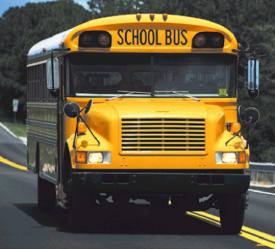The Business of Busing- A Transportation Report from the Scarsdale Schools
- Category: Schools
- Published: Wednesday, 30 October 2013 08:16
 Assistant Superintendent for Business Linda Purvis presented the business of busing in Scarsdale on October 21, 2013 to the Scarsdale community and the Board of Education at Fox Meadow Elementary School. Ms. Purvis discussed the different types of busing services that Scarsdale can opt into, the pros and cons of each, New York State Education Department requirements for transport, and how the transportation budget is currently being used.
Assistant Superintendent for Business Linda Purvis presented the business of busing in Scarsdale on October 21, 2013 to the Scarsdale community and the Board of Education at Fox Meadow Elementary School. Ms. Purvis discussed the different types of busing services that Scarsdale can opt into, the pros and cons of each, New York State Education Department requirements for transport, and how the transportation budget is currently being used.
In Scarsdale, students who live at least 1.5 miles from school qualify for transportation though New York State law mandates that only students who live more than 2 miles from an elementary or middle school, and more than 3 miles from a high school require transportation, so Scarsdale is relatively generous in this respect. Students must be offered transportation if they are attending an out-of-district private school, parochial school, or special education program.
There are three types of transportation that Scarsdale schools can choose from to provide to students who qualify:
1. Service delivery- This is an in-house service and is self-operated. Although it offers the highest level of service and the most flexibility, it is also the most costly.
2. Contracted services- The costs are lower at the beginning, but there is cost volatility down the road. There are no employee benefits with contracted services, although this will change with the implementation of the affordable care act.
3. Mandatory use of public transport- This is the most cost-effective means of transportation for students, but there is very high customer dissatisfaction.
Until 1991, bus service in Scarsdale was provided by a private company and the State of New York covered 90% of all costs associated with transporting students. After 1991, New York State lowered its contribution to only 6% of the cost of student transport. There are no monitors on the buses unless a special education student mandates it. The buses, to note, also transport senior citizens in the community and transport campers to Scarsdale summer camps.
In Scarsdale, 1,824 students live 1.5 miles or more from their schools and are offered bus service. This equates to 38% of students in the village.
Ms. Purvis was quick to point out the two-thirds of the dollars spent on transportation was spent busing students out of the district to non-public schools, while only one-third of the transportation budget was spent busing students to Scarsdale public schools. There are 364 students that attend 67 different private, parochial, or special education programs and are required to be offered a bus to these alternative schools. Of these 364 students, 103 are special education students that attend 37 different programs and require a total of 29 drivers during school hours. There are 261 private and parochial students that attend 30 different programs requiring 18 drivers. Ms. Purvis noted that due to similar drop off and pick up times and not wanting children to wait for long periods of time or spend more than 45 minutes on the bus, many buses and drivers are needed to perform the bus routes to all the various private, parochial, and special education programs.
The total current transportation budget is $5,419,371. Cost cutting is ideal but not necessarily realistic given the ramifications that would result. Ms. Purvis said that students could be assigned longer bus routes and would experience increased ride times; parents would likely not be in favor of this. She also suggested that there could be a central meeting spot for students riding out-of-district. However, given that the bus is one of the only services that taxpayers who send their children to private and parochial schools get, it is likely to be met with strong opposition. It is estimated that these cost cutting measures could save up to $200,000.
Board member Jonathan Lewis said, "Out of district is the most expensive. Linda will be giving us the likely budget scenario in November for how much over the cap we might be and $200,000 is a significant chunk."










